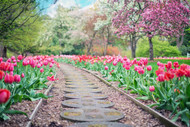Plant Feeds – what to choose and how to use.
Plants that you have in planters and pots will need feeding regularly, as they only have what you give them. However, plants in your garden beds and borders have ready access to the nutrients in the soil and may not need feeding. Some crops that do better with added fertiliser include fruit, vegetables and bedding plants.
What do your plants need?
All plants need three nutrients - Nitrogen (N), Phosphorous (P) and Potassium (K), commonly known as NPK. Nitrogen is for leaf growth, Phosphorous for the roots, and Potassium for flowering and fruit development.
Plants do also need other nutrients, such as calcium (Ca), sulphur (S) and magnesium (Mg), as well as zinc (Zn), iron (Fe), copper (Cu), boron (B) and manganese (Mn). General-purpose fertilisers contain smaller amounts of these.
The different types of plant feeds
It is important that you pick the right fertiliser for your specific plants. The most common ones include:
General Purpose Fertiliser – as the name suggests, this is an all-purpose fertiliser that will help with a wide range of plants. Add the fertiliser to the bottom of the plant hole and this will encourage the roots to develop and grow throughout the first season.
Granular Fertiliser – if you choose uncoated granules which are quick-release fertilisers, they will start to break down and release as soon as they get damp. If you choose coated granules which are controlled release fertiliser then these release continuously and work well mixed into the compost or garden soil. This method is very popular as the fertiliser will provide nutrients for up 6 months as and when the plants need it.
Specialised Fertiliser - acid loving plants such as heathers, rhododendrons and camelias need a special ericaceous fertiliser so they get the right nutrients to grow and flower.
Liquid fertilisers – available as a liquid or a soluble powder that you make up. These fertilisers are great for quick results and fixing nutrient deficiencies, however, they are not as long-lasting as the controlled or continuous release granular fertilisers.
Manure –This is a cost-effective option and is a great nutritional source for your plants provided it is well-rotted. This is best dug into your garden soil before planting,
When to feed
Feed your plants during the growing season which is throughout the spring and early summer months. There is no need to feed in late summer as this only encourages a flush of late growth that might get damaged by frost.
Sprinkle the recommended amount of fertiliser around your plants. It is important to water this in. If using a liquid feed, apply from a watering can.
Feed when:

